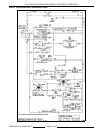
FULL SIZE GAS CONVECTION OVENS - ELECTRICAL OPERATION
F24682 (Rev. B, October 2007) Page 46 of 68
6. The oven will continue to cycle on the hold
thermostat until the ROAST & HOLD timer is
turned to the OFF position and the function
switch (S3) is change back to ROAST (normal
cooking) or the power switch (S1) is turned to
the OFF or COOL DOWN position.
Cool Down Cycle (Solid State Temperature
Control)
NOTE: The electrical sequence of operation for the
COOL DOWN cycle is written for ovens with the
ROAST & HOLD option.
1. Conditions.
A. Oven is ON.
B. Oven cavity temperature needs to be
lowered.
C. Doors are open.
1) Door switch contacts OPEN.
D. Roast and Hold timer in the OFF position.
E. Roast timer (normal cooking) in the OFF
position.
F. Function switch (S3) set to either Normal
ROAST cycle or ROAST & HOLD cycle.
2. Power Switch (S1) turned to COOL DOWN.
NOTE: With door switch contacts OPEN (doors
open), the convection fan motor will still run and
continue to cool the oven. However, power would be
removed from the following components: Power ON
light (goes out), Normal ROAST timer, ROAST &
HOLD timer, transformer T1 (de-energized) and to
the component cooling fan.
A. Power to motor speed (Hi/Low) relay (R1)
normally open (N.O.) contacts and to
common (C) on hold relay (R2). Power is
then connected through hold relay (R2)
normally closed (N.C.) contacts to motor
speed (Hi/Low) relay (R1) coil.
1) Motor speed (Hi/Low) relay (R1) is
energized and contacts change state.
a. Power is connected through
motor speed (Hi/Low) relay
normally open (N.O.) contacts,
through function switch (S3) to
Convection fan motor.
a) Convection fan motor
energized.
NOTE: If function switch (S3) is
set to Normal ROAST cycle, fan
speed will be high; if set to
ROAST & HOLD cycle, fan
speed will be low.
b) When Convection fan motor
reaches operating speed the
centrifugal switch on the
motor closes but no power
is available for connection to
other components.
B. Power to one side of the hold thermostat
contacts but is not transferred to other
components due to oven cavity
temperature above 160°F (thermostat
OPEN).
C. Power to terminal 7 on the solid state
temperature control but is not transferred
to other components due to temperature
control not being powered.
3. If door switch is CLOSED (doors closed), power
is supplied to one side of the following
components: Power ON light (Amber), oven
light switch (S2), Normal ROAST timer terminal
1, ROAST & HOLD timer terminal 1,
transformer primary (T1) and component
cooling fan.
1) Power ON light (Amber) comes ON.
2) Transformer (T1) energized.
a. Power (24VAC) to one side of
the following components: heat
relay (R3) normally open (N.O.)
contacts, high limit --- connected
through the normally closed
(N.C.) contacts to the 1
st
valve
(safety) on the dual solenoid gas
valve.
a) 1
st
valve (safety) on the gas
valve energized.
NOTE: Gas does not flow to the
burner until the 2
nd
valve (main)
is energized.
3) Component cooling fan.
4. The oven will remain in this condition until the
power switch (S1) is turned to the OFF or ON
position.
VC4GC, VC6GC
(Roast & Hold Standard on Computer Model)
Schematic diagram 10437 will be used to explain the
electrical sequence of operation for both the ROAST
cycle (normal cooking) and the ROAST & HOLD
cycle.


















